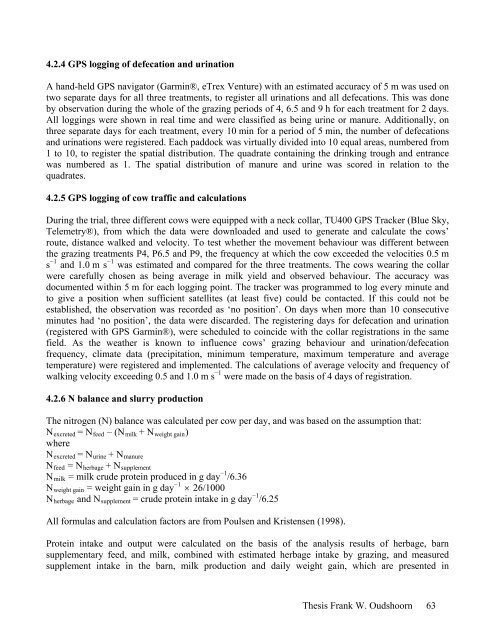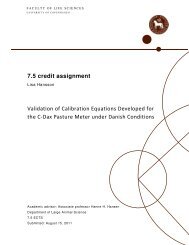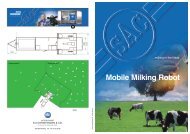Innovative Technology and Sustainable Development of Organic - 1.
Innovative Technology and Sustainable Development of Organic - 1.
Innovative Technology and Sustainable Development of Organic - 1.
Create successful ePaper yourself
Turn your PDF publications into a flip-book with our unique Google optimized e-Paper software.
4.2.4 GPS logging <strong>of</strong> defecation <strong>and</strong> urination<br />
A h<strong>and</strong>-held GPS navigator (Garmin®, eTrex Venture) with an estimated accuracy <strong>of</strong> 5 m was used on<br />
two separate days for all three treatments, to register all urinations <strong>and</strong> all defecations. This was done<br />
by observation during the whole <strong>of</strong> the grazing periods <strong>of</strong> 4, 6.5 <strong>and</strong> 9 h for each treatment for 2 days.<br />
All loggings were shown in real time <strong>and</strong> were classified as being urine or manure. Additionally, on<br />
three separate days for each treatment, every 10 min for a period <strong>of</strong> 5 min, the number <strong>of</strong> defecations<br />
<strong>and</strong> urinations were registered. Each paddock was virtually divided into 10 equal areas, numbered from<br />
1 to 10, to register the spatial distribution. The quadrate containing the drinking trough <strong>and</strong> entrance<br />
was numbered as <strong>1.</strong> The spatial distribution <strong>of</strong> manure <strong>and</strong> urine was scored in relation to the<br />
quadrates.<br />
4.2.5 GPS logging <strong>of</strong> cow traffic <strong>and</strong> calculations<br />
During the trial, three different cows were equipped with a neck collar, TU400 GPS Tracker (Blue Sky,<br />
Telemetry®), from which the data were downloaded <strong>and</strong> used to generate <strong>and</strong> calculate the cows’<br />
route, distance walked <strong>and</strong> velocity. To test whether the movement behaviour was different between<br />
the grazing treatments P4, P6.5 <strong>and</strong> P9, the frequency at which the cow exceeded the velocities 0.5 m<br />
s −1 <strong>and</strong> <strong>1.</strong>0 m s −1 was estimated <strong>and</strong> compared for the three treatments. The cows wearing the collar<br />
were carefully chosen as being average in milk yield <strong>and</strong> observed behaviour. The accuracy was<br />
documented within 5 m for each logging point. The tracker was programmed to log every minute <strong>and</strong><br />
to give a position when sufficient satellites (at least five) could be contacted. If this could not be<br />
established, the observation was recorded as ‘no position’. On days when more than 10 consecutive<br />
minutes had ‘no position’, the data were discarded. The registering days for defecation <strong>and</strong> urination<br />
(registered with GPS Garmin®), were scheduled to coincide with the collar registrations in the same<br />
field. As the weather is known to influence cows’ grazing behaviour <strong>and</strong> urination/defecation<br />
frequency, climate data (precipitation, minimum temperature, maximum temperature <strong>and</strong> average<br />
temperature) were registered <strong>and</strong> implemented. The calculations <strong>of</strong> average velocity <strong>and</strong> frequency <strong>of</strong><br />
walking velocity exceeding 0.5 <strong>and</strong> <strong>1.</strong>0 m s −1 were made on the basis <strong>of</strong> 4 days <strong>of</strong> registration.<br />
4.2.6 N balance <strong>and</strong> slurry production<br />
The nitrogen (N) balance was calculated per cow per day, <strong>and</strong> was based on the assumption that:<br />
Nexcreted = Nfeed – (Nmilk + Nweight gain)<br />
where<br />
Nexcreted = Nurine + Nmanure<br />
Nfeed = Nherbage + Nsupplement<br />
Nmilk = milk crude protein produced in g day −1 /6.36<br />
Nweight gain = weight gain in g day −1 26/1000<br />
�<br />
Nherbage <strong>and</strong> Nsupplement = crude protein intake in g day −1 /6.25<br />
All formulas <strong>and</strong> calculation factors are from Poulsen <strong>and</strong> Kristensen (1998).<br />
Protein intake <strong>and</strong> output were calculated on the basis <strong>of</strong> the analysis results <strong>of</strong> herbage, barn<br />
supplementary feed, <strong>and</strong> milk, combined with estimated herbage intake by grazing, <strong>and</strong> measured<br />
supplement intake in the barn, milk production <strong>and</strong> daily weight gain, which are presented in<br />
Thesis Frank W. Oudshoorn 63




